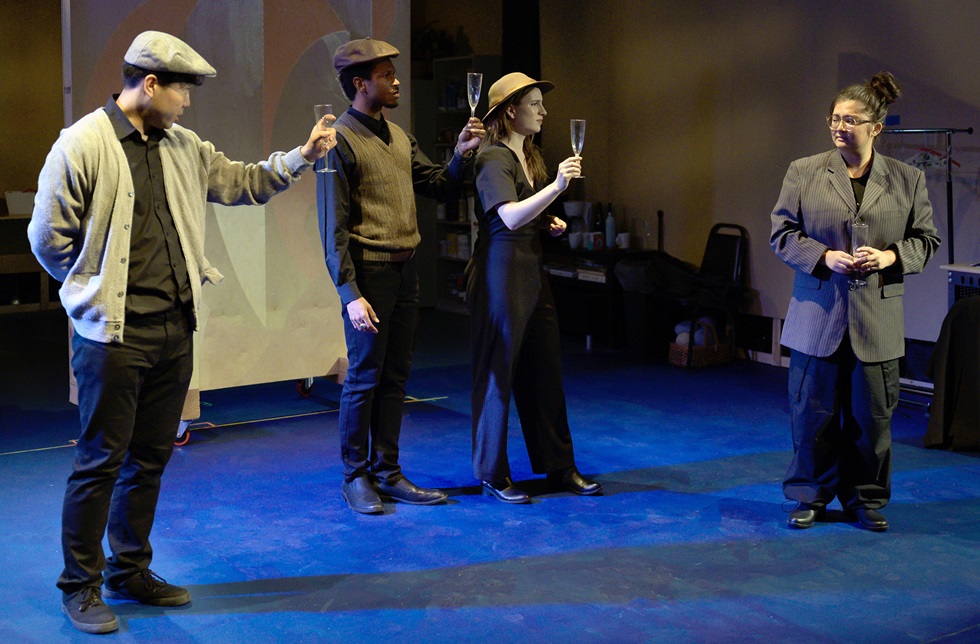
LOS ANGELES — This city’s Open Fist Theatre Company enjoys the distinction of presenting the world premiere production of playwright Tom Jacobson’s two-part The Bauhaus Project—Part 1: Bauhaus Weimar and Part 2: Bauhaus Dessau and Bauhaus Berlin.
These new plays, along with Jacobson’s Crevasse (reviewed separately), investigate the relationship of art and artists to post-World War I esthetic movements and the now seemingly inevitable, irreversible rise of fascism and anti-Semitism in Germany. Each of the Bauhaus plays is performed in two acts, with one intermission.
The character of these plays is frankly didactic, and Jacobson has certainly done his research. Few beyond the world of art historians today know what the Bauhaus movement was all about. By the end of the second play, some theatergoers may feel they’ve been exposed to just about all they’ll ever need to know, while others may be inspired to probe further into the lives and work of the fascinating, pioneering artists we meet in various fields such as architecture, painting, music, dance, textile design, interior and furniture design. Some of these names will certainly be familiar, such as architects Walter Gropius and Mies van der Rohe, modernist composer Arnold Schönberg, and painter Vasily Kandinsky.
The premise, as the first play starts out, is that five struggling Southern California art students—three males and two females—each with their own set of economic, family, and legal issues, are directed as their class project to create a dramatic presentation on the history of the renowned Bauhaus School, which existed (one hesitates to say “flourished”) from 1919 to 1933. It was established first in Weimar, a small but historic town in eastern Germany which some of the greats of German culture—Schiller, Goethe, and others—made famous. It was for this town that the post-war Weimar Republic was known.

“The Bauhaus Project takes place on several levels,” explains Open Fist artistic director Martha Demson, who worked closely with Jacobson to develop the piece and is the project’s director. “The framing device is a play within a play in which modern-day art school students trace the historical narrative of the Bauhaus, a groundbreaking art school committed to ‘marrying beauty with utility’ that was closed by the Nazis in 1933. Meanwhile, the production design will emphasize the enormous influence of the Bauhaus and the exhilaration of cross-disciplinary collaboration.”
The Bauhaus movement (the word translates something like “building the house”) originated in the wake of Germany’s destruction and loss from World War I. Rebuilding the economy involved recruiting crafts, trades, and professionals to come together and figure out how to start up mass production of quality goods and buildings whose designs could be sold to manufacturers. That also meant re-educating the public as to what was beautiful, utilitarian, and economical, with clean lines, little ornamentation, and studied functionality. That esthetic demanded flat roofs, for example, exposed air ducts, and little of what could be called “art for art’s sake.” New materials were called into use, such as cellophane and rayon. The faculty thought of themselves as creating a new “Gesamtkunstwerk,” Richard Wagner’s term for his operas representing a totality of all the arts, but now broadened to include a far wider range of fine and practical arts.
The best and most forward-looking practitioners in every field were called upon to teach at the Bauhaus. Tensions arose between those who put their individual art or design before their collective collaboration, and also between the apolitical and others who backed either Soviet-style communism or the rising Aryan nationalism of the right-wing. As time would prove, the Jewish faculty and students came to be a despised class as white Aryanism spread its roots. A conversation in Bauhaus 2 slyly poses that what the world should be concerned about was not so much “the Jewish Question” but “the Christian Question.”
The five art students are Jack Goldwait playing Owen Winston Hughes, Sang Kim as Duck Liu, Katarina Joy Lopez as Ellis Anderson, Chloe Madriaga as Brec Takahashi-Blum, and John C. Sweet as Kai Lee-Du Bois Robinson. Each of them, in turn, portrays multiple historic Bauhaus figures who passed through the different phases of its career. Many of these figures later fled to the U.S., some died in concentration camps, and a few went on to serve the Nazi regime.
Act 1 of the first play focuses on the present-day students as they start investigating the characters they will play, people such as architect and Bauhaus founding director Walter Gropius and his successors, architects Hannes Meyer and Ludwig Mies van der Rohe; painters Paul Klee, Vasily Kandinsky, Oskar Schlemmer, and Lyonel Feininger; textile artists Gunta Stölzl, Maria Kipp and Otti Berger; furniture designer Marcel Breuer; photographer Laszlo Moholy-Nagy; graphic designer Herbert Bayer; composers Arnold Schönberg and Alma Mahler (widow of Gustav Mahler, wife of Walter Gropius, lover of writer Franz Werfel); and architects Ludwig Hilberseimer and Fritz Ertl—the latter of whom would go on to design buildings at Auschwitz. Act 2 presents their play about the Weimar years, 1919-1925, recapitulating much of what we learned in the first act.

My companion and I found the first act slow-going, with too much information about the students themselves, whose personal issues are largely irrelevant to the Bauhaus history we will learn about in the second act. When we left the theatre, anticipating Part 2 the next day, we imagined there might be a similar format for the rest of the project, and prognosticated that a much more economical deployment of the company’s resources—and theatergoers’ time!—might have been to cut much of the groundwork in the first play’s first act as unnecessary to the matter at hand, and do the whole project in one longer play: Weimar in the first act, then Dessau and, after a brief pause, Berlin to wind up: Over and done. After the second day, we still felt that would have been a clearer, sleeker, more audience-friendly solution.
The second play treats the Bauhaus removal to Dessau. Weimar had gotten too controversial, and too political, and Fritz Hesse, Lord Mayor of Dessau, positively welcomed the school to his city, where it survived a growingly hostile nationalist influence on the City Council from 1925 to 1932. Now for the first time, Bauhaus inventors had actually come up with designs and products suitable for mass production, and manufacturing contracts for them helped to make the school self-sufficient. And then a short final act in Berlin, where defunding and suspicion turned into outright threats and arrests once the Nazis took over in 1933, and the Bauhaus was no more.
Jacobson pays more attention than the topic merits to the bizarre cult embraced by Johannes Itten (1888-1967), a Swiss expressionist painter who developed the Bauhaus core courses. He is still remembered for his theoretical work on color, but at the time he promoted his Mazdaznan religion, of which, at least at the school, he was chief poohbah. Other faculty members tried to overlook his strangeness, but he wielded an unnatural power over his students, some of whom, attracted to his authoritarian command, eventually drifted toward National Socialism. Not to take anything from her personally, but only considered theatrically, a peripheral character who sucks up a lot of space is the talented and ambitious Alma Mahler who was not part of the Bauhaus herself.
Bauhaus 2 spins out much more flowingly, with only the briefest reappearance at the end by the original California art students, who have fulfilled their assignment and graduated. By the time the project concludes, we have truly come to understand how, though the Bauhaus lasted but 14 years, its influence, diffused by its leading faculty members for decades to come, still exerts an influence over our concept of design, beauty and purpose. Our grasp of this story comes at a price, however, that of the playwright’s indulgence in detail, pointless spotlighting of too many minor characters, a seeming inability to edit himself. As in Crevasse, Jacobson shows himself a master at getting his actors to portray multiple characters with split-second timing.
The Open Fist creative team includes scenic designer Richard Hoover, lighting designer Gavan Wyrick, composer and sound designer Tim Labor, projections designer Gabrieal Griego, costume designer Michael Mullen, prop masters Bruce Dickinson and Ina Shumaker, and assistant director Sarah Zuk. Martha Demson and Amanda Weier produce for Open Fist Theatre Company, and Nychelle Hawk is associate producer.
Performances of The Bauhaus Project take place through August 25. Part I, on Weimar, runs Fri. at 8 p.m. and Sat. at 4 p.m., while Part 2, on Dessau and Berlin, plays on Sat. at 8 p.m. and Sun. at 4 p.m. Audience members can choose to view the entire Bauhaus Project over the course of two evenings (any Fri. and any Sat. at 8 p.m.); two matinees (any Sat. and any Sun. at 4 p.m.); or on a single Sat. at 4 p.m. and 8 p.m. (The history is sequential, so it is not advised to view the parts out of order.) Atwater Village Theatre is located at 3269 Casitas Ave. in Los Angeles 90039. A combination ticket to both Parts 1 and 2 is $50, while admission to a single part is $35. Students receive a $5 discount. To make reservations for The Bauhaus Project, call (323) 882-6912 or go to the Open Fist website. A three-play package (Bauhaus Parts 1 and 2, and Crevasse) is available for $75 and can be purchased at either Open Fist or the Victory Theatre Center website.
We hope you appreciated this article. At People’s World, we believe news and information should be free and accessible to all, but we need your help. Our journalism is free of corporate influence and paywalls because we are totally reader-supported. Only you, our readers and supporters, make this possible. If you enjoy reading People’s World and the stories we bring you, please support our work by donating or becoming a monthly sustainer today. Thank you!










